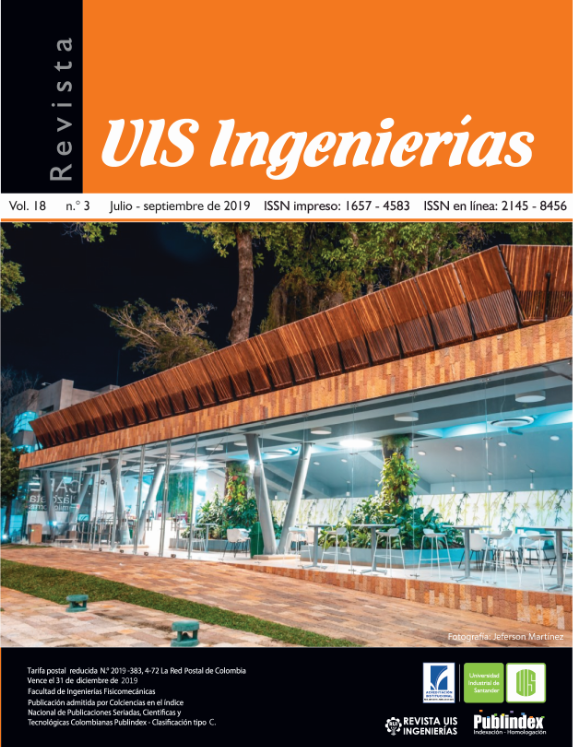Dynamic amplification factor due to sudden fall of the form traveler during the balanced cantilever construction of box girder bridges
Published 2019-05-24
Keywords
- box girder bridge,
- balanced cantilevers,
- fall of the advance carriage,
- dynamic amplification factors
How to Cite
Abstract
The balanced cantilever method stands out among the most commonly used construction methods for box girder bridges. In this method, the superstructure is built progressively and quasi-symmetrically with respect to the pier. Form travelers that are supported on a predecessor segment allow pouring the following one. The accidental fall of the form traveler is a potential risk during construction; thus, some design guidelines recommend the use of a dynamic amplification factor (DAF) of 2.0 to account for the dynamic effects during the event. The use of a static-analysis is performed along with the use of the DAF. The validity of this approach was investigated in this study by performing dynamic analysis on the girder flexural rigidity, on the construction stage at which the accident occurs and on the breakage time and function that simulate the accidental event. The larger values of DAF occurred in relatively flexible superstructures, and the critical construction stages were those before the closure pour at mid-span. Moreover, the recommendation in the design guidelines was found inadequate as some of the analyzed cases had DAFs equal to 3.0. This demonstrates that the use pseudo-static analysis method is not the correct approach for these accidental situations.
Downloads
References
[2] AAHSTO Código Americano de Diseño Sísmico de Puentes, AAHSTO, 2012.
[3] K. Ahmadi-Kashani, “The landmark Metsovitikos Bridge, Greece,” Proc. Inst. Civ. Eng. - Bridg. Eng., vol. 161, no. 4, pp. 165–176, 2008, doi: 10.1680/bren.2008.161.4.165.
[4] The European Union, Eurocode 1: Actions on structures - Part 1-7: General actions - Accidental actions. 2006.
[5] MIDAS CIVIL 3D. Licencia Universidad Industrial de Santander.
[6] C. M. Mozos and A. C. Aparicio, “Parametric study on the dynamic response of cable stayed bridges to the sudden failure of a stay, Part I: Bending moment acting on the deck,” Eng. Struct., vol. 32, no. 10, pp. 3288–3300, 2010, doi: 10.1016/j.engstruct.2010.07.003.
[7] C. M. Mozos and A. C. Aparicio, “Parametric study on the dynamic response of cable stayed bridges to the sudden failure of a stay, Part II: Bending moment acting on the pylons and stress on the stays,” Eng. Struct., vol. 32, no. 10, pp. 3301–3312, 2010, doi: 10.1016/j.engstruct.2010.07.002.
[8] C. M. Mozos and A. C. Aparicio, “Numerical and experimental study on the interaction cable structure during the failure of a stay in a cable stayed bridge,” Eng. Struct., vol. 33, no. 8, pp. 2330–2341, 2011, doi: 10.1016/j.engstruct.2011.04.006.
[9] A. M. Ruiz-Teran and A. C. Aparicio, “Dynamic amplification factors in cable-stayed structures,” J. Sound Vib., vol. 300, no. 1, pp. 197–216, 2007, doi: 10.1016/j.jsv.2006.07.028.
[10] A. Ruiz-Teran and A. Aparicio, eliminating bridge piers using stay cables with unconventional layouts. Taylor & Francis Group, 2008. doi: 10.1201/9781439828410.ch105
[11] A. M. Ruiz-Teran and A. C. Aparicio, “Response of under-deck cable-stayed bridges to the accidental breakage of stay cables,” Eng. Struct., vol. 31, no. 7, pp. 1425–1434, 2009, doi: 10.1016/j.engstruct.2009.02.027.
[12] M. Rosignoli, “Robustness and Stability of Launching Gantries and Movable Shuttering Systems – Lessons Learned,” Struct. Eng. Int., vol. 17, no. 2, pp. 133–140, May 2007, doi: 10.2749/101686607780680673.
[13] Setra, Haubans. “Recommandations de la Commission Interministerielle de la Precontrainte”. Service d’Etudes Techniques des Routes et Autoroutes, Bagneux, Francia, 2001.
[14] W.-F. Chen and L. Duan, Handbook of international bridge engineering. Taylor and Francis, 2013.
[15] M. Wolff and U. Starossek, “Cable loss and progressive collapse in cable-stayed bridges,” Bridg. Struct., vol. 5, no. 1, pp. 17–28, Mar. 2009, doi: 10.1080/15732480902775615.

